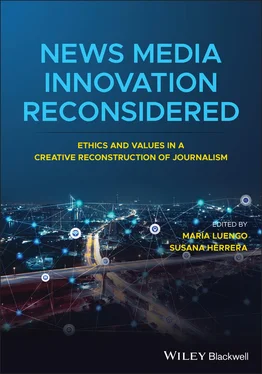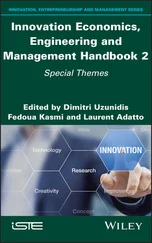Other current ethical concerns specify the cultural performance of new journalistic forms, practices, and processes within the area of algorithms, bots, and automatization. Rojas Torrijos’s Chapter 8focuses on the ethics of journalism generated by machines. Barceló-Ugarte et al.’s Chapter 9explores the specific incorporation of artificial intelligence (AI) into Spanish public television’s workflows, emphasizing the ethical challenges posed by the different phases of newsgathering, documentation, writing, publishing, archiving, and audience analysis. As Chapters 8and 9explain, AI is changing the way in which news is created.
Most of these changes—to give an example, in May 2020, Microsoft was accused of sacking journalists working at its MSN website and replacing them with AI software (Waterson, The Guardian , May 30, 2020)—are interpreted as threats to journalism. Yet layoffs of journalists by digital publishers are not the only reason for seeing automated technology as foreshadowing journalism’s extinction. A few weeks after the layoffs at Microsoft, MSN.compublished a news story about the mixed-race pop star Jade Thirlwall’s personal reflection on racism; the story was illustrated with the wrong mixed-race member of the singer’s band, Little Mix. Thirlwall had been attending a Black Lives Matter protest in London. The anecdote triggered widespread criticism within the media of Microsoft’s employment of robots that cannot differentiate mixed-race individuals. More significantly, it echoed current ethical debates on alleged racist biases (and other types of human distortions) in AI software coding.
Rojas analysis of some of the best practices of AI journalism shows that a “semi-automated” journalism, in which human reporters and robots work together, might help to overcome criticism focused on software’s biases as well as another ethical challenges that AI poses to journalism. The selected initiatives show how algorithms and bots are used by leading journalistic organizations to broaden news media coverage and enhance high-quality reporting on public-interest issues, such as police information on homicides ( Los Angeles Times ) or earthquake warnings ( Los Angeles Times and Oregon Public Broadcasting). These journalistic projects bring to the forefront of news media innovation the combination of old and “new guiding principles” for a new digital era of journalism (McBride and Rosenstiel, 2014)—for example, verification, rigor, depth, civil engagement, or community.
Taking the British Press Association’s automated news service RADAR (Reporters and Data Robots) as an example, Rojas Torrijos ( Chapter 8) highlights the community value of algorithmic journalism, which is currently meeting “the increasing demand for fact-based news for local communities” by delivering data-driven localized versions of stories to the UK’s local newsrooms (PA Media Group, 2018). Likewise, in other countries around the world, semi-automated news is filling the gap left by the disappearance of local reporting, and consequently it is contributing to building a sense of community. The combining of speed and verification, as well as of reporting and investigation, and the providing of both public interest news and community-driven stories are, among other professional and civil values, the basis of journalism innovation achieved through AI. New semi-automated journalistic practices mirror the way in which journalism is, to quote Rojas Torrijos, “acquiring a new vision that can cope with change so as to make professional ethics the guiding thread that anchors and stimulates innovation” (Rojas Torrijos, Chapter 8).
This book ends with a section devoted to the public. Contributions to this section revisit core ethical debates on big data (Cancela-Kieffer, Chapter 10), the personalization of news (Pedrero-Esteban and Gas-Gozalbo, Chapter 11), transparency (Christofoletti, Chapter 12), and verification (Espíritusanto and Dinant, Chapter, 13), posed by the previous chapters, to reflect on journalism’s mission to inform the public in times of post-truth, distrust of institutions, echo chambers, big tech, and social and political shocks.
Christofoletti’s Chapter 12questions transparency to rethink journalism’s professional culture. When promoting transparency, does journalism itself become more open and contextualize its own products, practices, and modus operandi? For Christofoletti, transparency in journalism “is not an end in itself, but a path” to replace arrogance with humility, narcissism with dialog, and to create and develop newsrooms that are more publicly exposed and more willing to review procedures. The author explores new civil and journalistic initiatives based on this new culture of transparency that are helping journalism to implement new trust-building strategies. By the same token, Espíritusanto and Dinant ( Chapter 13) use verification and the question of how people can ascertain the truthfulness of a news story to explore innovative technological tools to empower citizens to fight against misinformation.
In Chapter 10, Cancela-Kieffer argues that the only way for journalism to navigate a disrupted data-driven society is to fully embrace its core mission: “safeguarding ‘the people’s right to know.’” She advocates for creativity and for a “radical collaborative journalism” involving other disciplines—for example, mathematics and coding. She appeals to a journalistic culture of objectivity (the separation of facts from opinion) and self-criticism to combat subjectivity and self-defensiveness. Cancela-Kieffer argues that technology allows journalists to bring “personalized experiences” into people’s lives. “Small data,” a simpler and more local form of data journalism, she observes, has demonstrated the significant contribution that the “granularity” of data (detailed demographic maps of neighborhoods, crime statistics, sensors, etc.) can make to “uncover disparities and inequalities.”
When journalists attempt to stand on the side of their public by choosing, preparing, and telling stories in a way that helps the public to be informed participants in democratic society, the ethics of news innovation become a real challenge. Too often media scholars offer only more reasons to despair. Overall, the reader will find grounds for optimism in these pages. This positive spirit was what inspired this collective book project.
Some of the texts in this book were first drafted for the IAMCR preconference “News Media Innovation Ethics: Activating Human and Civil Rights Through Core Professional Values,” held at Carlos III University (Madrid, July 6, 2019). An enriching dialog between participants (including scholars and practitioners specializing in news media innovation) and organizers (the editors of this book) started before the conference and kept going during and after it. Our book reflects this continuous conversation as well as the further engagement with each contributor that was undertaken by the editors to unify the various texts around the aim, themes, and scope of the book.
1 Alexander, J.C. (2004). Cultural pragmatics: social performance between ritual and strategy. Sociological Theory, 22(4), 527–573.
2 Alexander, J.C. (2016). Introduction: journalism, democratic culture, and creative reconstruction. In Alexander, J.C., Breese, E.B., and Luengo, M. (Eds.). The Crisis of Journalism Reconsidered: Democratic Culture, Professional Codes, Digital Future. Cambridge/New York: Cambridge University Press, pp. 1–28.
3 Alexander, J.C., Breese, E.B., and Luengo, M. (2016). The Crisis of Journalism Reconsidered: Democratic Culture, Professional Codes, Digital Future. Cambridge/New York: Cambridge University Press.
4 Boczkowski, P.J. (2004). Digitizing the News: Innovation in Online Newspapers. Cambridge, MA: The MIT Press.
Читать дальше












